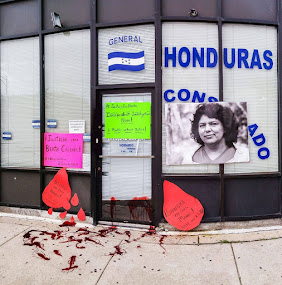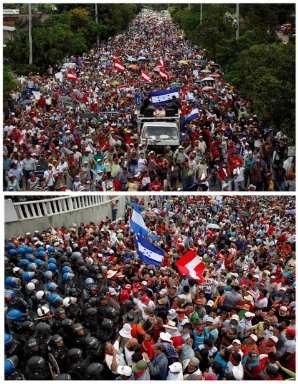(Police truck spraying vaste quantities of teargas at peaceful protesters, March 30, 2011, Tegucigalpa. All photos, Karen Spring, Rights Action, March 30, 2011, Tegucigalpa.)
 ON THE STREETS OF TEGUCIGALPA, ENDLESS REPRESSION BY MILITARY-BACKED REGIME
ON THE STREETS OF TEGUCIGALPA, ENDLESS REPRESSION BY MILITARY-BACKED REGIME
By Karen Spring (Rights Action, Tegucigalpa, March 30, 2011
Today, a National Strike was called in Honduras by the public sc
hool teachers and the National Front of Popular Resistance to protest the last two weeks of brutal and fierce repression, the eighteen political prisoners on trial and the attempt of the post-coup regime and international financial institutions to privatize public education.
In various key locations in all areas of the country, thousands of H
ondurans occupied major roads, bridges and universities to participate in the National Strike. Most protests and gatherings were repressed and unconfirmed reports say that at least 46 people were illegally detained, many injured and one killed during the violent evictions throughout the country.
In Tegucigalpa, I experienced a snap shot of the repression that occurred throughout Honduras as the police, military and the post-coup Pepe Lobo regime evicted, illegally detained, beat and shot at with tear gas and live bullets the public school teachers and the pro-democracy people’s movement.
EVICTION AT STIBYS
In the morning, I arrived at the road occupation in front of the STIBYS (National Drink & Bottling Union) headquarters just as a large line of police in riot gear along with the police water tank marched towards the people and began firing tear gas and drawing their batons.
I walked in the opposite direction and into the rows of transport trucks, cars & impatient drivers in the traffic jam that built up since the beginning of the road occupation earlier that morning. I began running away from the clouds of dispersing gas while being pushed by panicked people scared to get stuck and to breath in the poisonous gas that was still being fired by police a far distance behind us.
After the repression had died down, I went back to the STIBYS building to find a group of men throwing buckets of water on dried bushes, grass and trees in a gulley next to STIBYS that had caught fire during the eviction approximately 50 meters from a gas station and even less from a large propane tank. At that
point, the fire had been contained but smoked still rose from the burning bushes.

When I arrived at the STIBYS entrance, I found out that many people had been stuck inside the building
(that is roughly 30 metres from the road) during the eviction and that police had shot approximately 30 tear gas canisters inside the STIBYS property, at the entranceway and inside the building.
Many were experiencing severe breathing problems and one young girl, roughly 16 years old, was sitting on the crowded floor, crying and with a large bruise forming on her left arm above her elbow
where police had hit her with a baton.
Half an hour later, after speaking with people that had returned after the eviction, I left and headed for the Supreme Court, 10 minutes down the road.
PROTEST AT THE SUPREME COURT: FREEDOM FOR THE 18 POLITICAL PRISONERS
I arrived at the gathering in front of the Supreme Court around mid-day to find a large crowd of public school teachers and various social organizations awaiting the results from the legal hearing occurring at that time in Court.
Eighteen teachers arrested last Friday, March 25th that have been held since then in the National Penitentiary in Tegucigalpa were on trial and being charged with sedition and illicit protest, two charges often laid in Honduras to criminalize protesters.
We were told that results would not be known until later in the afternoon. After hearing of the potential eviction of the road occupation in front of the National Autonomous University (UNAH) on Radio Globo, I decided to go to the University.
EVICTION AT THE NATIONAL AUTONOMOUS UNIVERSITY
At the UNAH, I spent roughly two hours behind a line of police heavily armed (likely by US and Canada military aid to the post-coup regime) and in full riot gear they shot tear gas, threw rocks, sprayed high-pressured water from tanks at student protesters at the National Autonomous University.

As I arrived at the moment the police began to evict the road occupation in front of the University, I stood behind the police line observing the hour and a half
battle between heavily armed state forces and protesters.
One young male student that strayed from the protesters was pointed out and chased down by a young man (that was later identified as a police officer dressed in civilian clothes) with riot police close behind him.
The student was first tackled by the infiltrated police officer and seconds later four to six officers dressed in riot gear with their batons drawn. As I arrived metres away, a fight had broken out between two officers near the now hurt student lying tackled and trampled on the ground.
Apparently, one of the officers that had tackled the student had drawn his pistol and was pointing it at the student lying on the ground. The other officer was screaming at him, pushed him away and ordering him to put his gun away. It was a very intense moment particularly as many police arrived to surround the student, most kicking or hitting him with their batons.
The student was violently lifted from the ground, again hit more than a dozen times with the wooden batons that the police carried then dragged and pushed to the police patrol. In the hour and a half I stood behind the police, 5 students were arrested and taken to the police post in the neighbourhood, the Kennedy.

As it is required by law that state forces respect the autonomy of the UNAH, police and military cannot enter the University (even though the University’s autonomy has been violated many times since the June 28th, 2009 military coup), many students who were and were not participating in the occupation, ran into the University to flee the repression and tear gas (even though moments before police had shot tear gas inside and had entered to moment later be chased out by protesters).
One student approached me asking me if I was a journalist and then reported how he had shown up for classes to find the University in chaos. He told me that the Director of the University, Julieta Castellanos, had opened the University, insisting that classes commence despite the repression that had ensued for weeks at the University. He told me he had not been participating in the road occupation and that he had simply arrived to attend his classes to find it impossible to enter or be inside the University safely.
As the police waited for the orders to enter the University, metres from the gates, to arrest, beat up and repress those they could find, a Honduran human rights organization mediated an agreement between the student and the police.
Even though I was there at the University during the day and listening to reports from different areas of the country on radio throughout the day, the actual number of people illegally detained and injured from the UNAH and throughout the country is unknown and difficult to confirm at the writing of this article.
In such chaos, it is difficult for human rights organizations to confirm injuries and deaths. From the protest in northern Colon, it still has not been confirmed the status of the woman that was reported killed by police.
Re-posted from Rights Action.











No comments:
Post a Comment